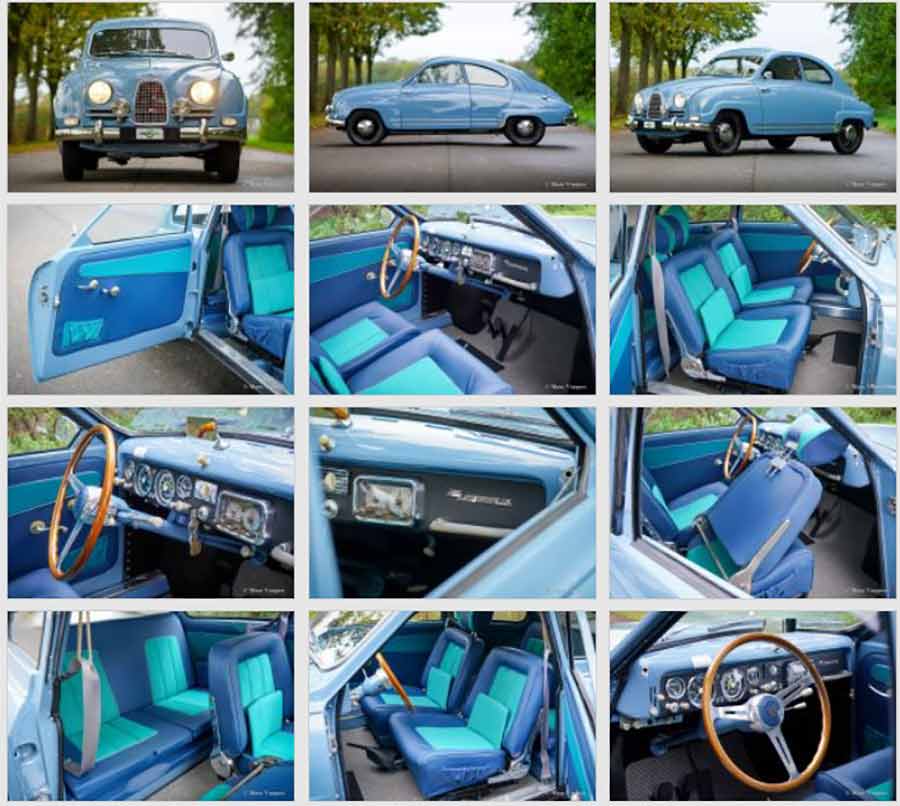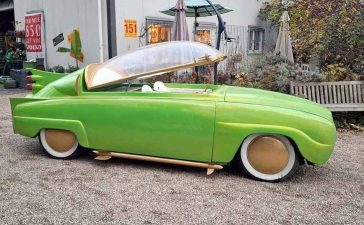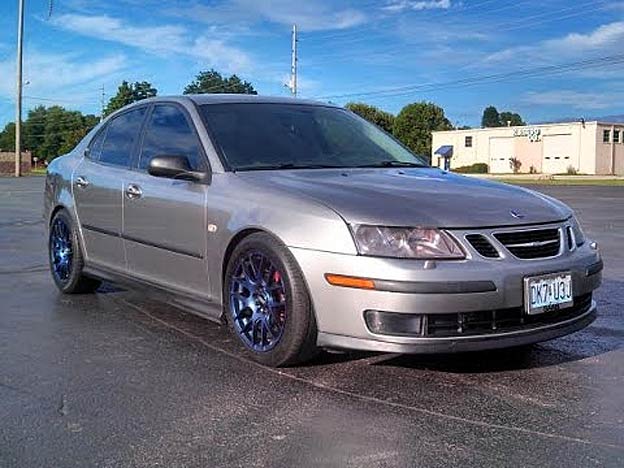A Saab So Rare It Sits Right Behind Ursaab and Sonett I
Within the world of Saab collectors, rarity is not just a matter of numbers – it is a matter of lineage, purpose and the intentions behind a model’s creation. By that measure, the Saab 93B Granturismo 750 occupies a place that few enthusiasts fully appreciate. Only four known examples remain, and among them, very few approach the correctness and preservation of the car now offered by Classic Open. In the hierarchy of scarce Saabs, only the Ursaab prototypes and the Sonett I racers sit above it. Everything else – even the early 92s, the two-strokes, the Monte Carlos and the rare export variants – exists in far higher numbers.
This alone makes the GT750 remarkable. But its real significance lies in the role it played within Saab’s early development. Built during a period when the company was still defining what a Saab automobile should be, the GT750 was the first attempt to merge sportiness, long-distance comfort and a more premium cabin into a compact Swedish package aimed at American buyers.
Engineering Roots: From Aircraft Streamlining to Two-Stroke Agility
Saab’s pivot from aviation to automobiles after the Second World War is a well-known foundation story, but for the GT750 it matters even more. The Saab 92, the company’s first production car, set the template with its wind-tunnel-shaped body and front-wheel-drive layout. The early two-stroke engines, based loosely on DKW solutions, were simple but responsive, delivering torque immediately and encouraging a driving style built around rhythm and momentum.
These ingredients made the early Saabs unexpectedly effective in rally competition. Their light weight, aerodynamic bodies and predictable traction allowed drivers like Erik Carlsson to achieve results far beyond what anyone expected from a small Swedish manufacturer. That motorsport experience shaped the next generation of cars, and by the mid-1950s Saab was ready to introduce something more ambitious than a basic sedan.
The GT750 was created exactly at that crossroads – a moment when the company began asking whether it could build a car that was still compact and light, but also more powerful, more comfortable and tailored to international tastes.
New York, 1958: Saab Presents a Grand Touring Experiment
The 1958 New York Automobile Show marked Saab’s most confident step toward the American market. For the event, the company prepared a special version of the 93B, refined and upgraded after it left the main assembly line. These cars were sent to a separate specialist department where technicians hand-modified the intake, carburetion and internal components of the three-cylinder two-stroke engine. What emerged from that process was a lively 748 cc unit producing 50 hp, and later a more focused 57 hp “Super” variant intended for competition.

In an era when similarly sized European cars rarely exceeded 30–35 hp, this was not a trivial increase. Combined with the 93’s modest weight, the GT750 had a brisk, energetic character that reflected Saab’s rally heritage more than its modest displacement suggested.
The interior also took a noticeable step forward. Saab equipped these cars with a unique dashboard layout, a wood-rimmed steering wheel and a new set of adjustable seats. The cabin no longer felt purely functional; it aimed for a more refined atmosphere, something Saab had not attempted before. Just as importantly, the GT750 became the first Saab to include seatbelts as standard equipment, a small but meaningful signal of the safety philosophy that would define the brand for decades.
A Short Production Life and an Even Shorter Survival List
Initial interest from the US dealers was encouraging, but the momentum waned quickly. Saab had originally envisioned building 500 to 600 cars, yet final production likely did not exceed 250 to 300 units. Many were driven hard, maintained inconsistently or modified outside factory specifications. Some disappeared entirely; others survived only in fragmented form.
The number of complete, authentic GT750s that remain traceable today is believed to be 4. That places this model in exceptionally rare company. It is unusual for a production-based Saab from the 1950s to be rarer than factory prototypes, yet the GT750 occupies exactly that position in the historical record.
The car offered by Classic Open stands out because its provenance is unusually clear: originally sold new in the United States in 1959, later found its way back to Europe, and ultimately underwent a restoration that pursued absolute fidelity to factory specifications.
A Deep Restoration Done the Right Way
When the car arrived in the Netherlands in 2018, it was not subjected to cosmetic improvements or selective refurbishment. Instead, the body was stripped to bare metal, revealing exactly what decades in the US climate had done to the steel structure. Every panel was corrected, repaired or reshaped to match original contours. The mechanical components – engine, gearbox, freewheel unit, suspension and brake system – were disassembled and rebuilt by specialists familiar with early Saab construction.

The interior received the same level of attention. Period-correct vinyl, cloth and stitching patterns were sourced and reproduced. The distinctive blue-green upholstery with silver piping was recreated according to archival photographs. The special dashboard layout and the wood-rimmed steering wheel, both defining features of the GT750, were restored with care that goes beyond what is typically seen even among concours restorations of period Saabs.
Nothing in this car feels improvised. Every surface, every switch and every mechanical component reflects Saab’s factory intentions as closely as is realistically possible today. This is the essential quality that makes the car suitable not only for private collections but also for museums that aim to preserve accurate examples of early Scandinavian automotive history.
Driving Character and Technical Identity
Although the GT750 was based on the standard 93B platform, the hand-modified engine is what gives the car its personality. The 748 cc three-cylinder two-stroke produces 50 hp and 80 Nm, but the character of the power delivery is far more distinctive than the numbers suggest. The engine revs with an immediacy typical of two-strokes, and the car’s roughly 790 kilograms create an agile, lively feel at lower speeds.
The familiar three-speed manual gearbox remains in place, along with the freewheel mechanism that disengages the drivetrain on deceleration to prevent oil starvation. This small engineering detail is one of the most Saab-like features of the entire era – a clever, practical solution to a technical limitation that Saab turned into a driving characteristic.
Top speed reached about 85 mph (135 km/h), roughly equal to or better than many contemporary small sports sedans, and entirely competitive with the European imports America was beginning to explore.
Why This Car Resonates With Collectors Today
Collectors who pursue early Saabs tend to look for a combination of authenticity, rarity and historical significance. The GT750 sits precisely at that intersection. It represents a transitional moment when Saab was testing the boundaries of what its cars could be. It demonstrates how lessons from aviation and rally competition could influence a grand touring concept. And it tells a story about Saab’s early ambitions in the United States – a market that would become central to the brand’s identity in later decades.
What strengthens the appeal of this particular example is its restoration quality. Many surviving early Saabs are enjoyable drivers or partially correct survivors, but few can claim museum-grade restoration aligned to original factory finishes. This car stands apart because it preserves not only the form of the GT750 but also its intent.
For a collector who understands the significance of early Saab engineering experiments, this car offers something unusually rare: a complete and faithful look at a brief moment when Saab was attempting to redefine itself long before the turbocharged era.
A Lasting Impression From Saab’s Formative Years
The 1959 Saab 93B Granturismo 750 is more than a preserved vehicle from the past. It encapsulates a chapter of Saab history that often remains hidden behind the better-known rally victories and later turbocharged icons. It shows how far Saab was willing to go in the late 1950s to explore a path toward grand touring refinement. And it demonstrates how a company shaped by aviation could combine aerodynamic logic, lightweight engineering and performance-oriented craftsmanship in ways that were radically different from its competitors.
With only four survivors confirmed, and with this particular example restored to a level that honors its origins without altering them, the car being offered by Classic Open is one of the most accurate and compelling GT750s left in existence. For a Saab collector who understands how small production decisions in the 1950s shaped the company’s identity for decades, this is a rare chance to acquire a piece of that story.











